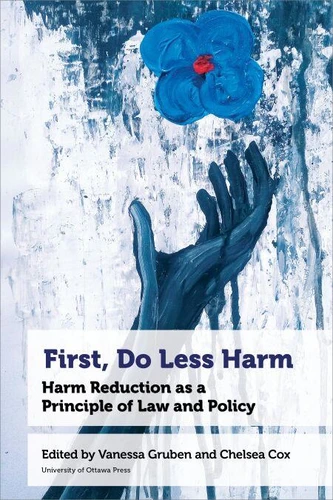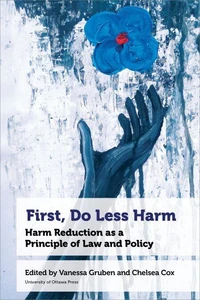First, Do Less Harm. Harm Reduction as a Principle of Law and Policy
Par : , , , ,Formats :
Disponible dans votre compte client Decitre ou Furet du Nord dès validation de votre commande. Le format ePub est :
- Compatible avec une lecture sur My Vivlio (smartphone, tablette, ordinateur)
- Compatible avec une lecture sur liseuses Vivlio
- Pour les liseuses autres que Vivlio, vous devez utiliser le logiciel Adobe Digital Edition. Non compatible avec la lecture sur les liseuses Kindle, Remarkable et Sony
 , qui est-ce ?
, qui est-ce ?Notre partenaire de plateforme de lecture numérique où vous retrouverez l'ensemble de vos ebooks gratuitement
Pour en savoir plus sur nos ebooks, consultez notre aide en ligne ici
- Nombre de pages278
- FormatePub
- ISBN978-0-7766-4196-6
- EAN9780776641966
- Date de parution25/02/2025
- Protection num.pas de protection
- Taille4 Mo
- Infos supplémentairesepub
- ÉditeurUniversity of Ottawa Press
Résumé
Readers will be able to gain a deeper understanding of how different approaches to harm reduction can create a stronger foundation for more effective policies and legislation. Scholars from law and social sciences collaborate with frontline organizations as well as with individuals with lived experience to reflect diverse perspectives, and transform how society addresses substance-related challenges.
Each chapter provides unique findings, drawing from examples of harm reduction strategies implemented for opioids, cannabis, and tobacco in Canada and beyond. While harm reduction has been a central aspect of the legal and policy responses to all three substances, its application has varied significantly. First, Do Less Harm explores how the ongoing opioid crisis emphasizes the pressing need for safe consumption sites and life-saving tools like naloxone.
Case studies on Canada's legalization of cannabis highlight both the benefits and challenges of providing legal and regulated access to a drug. The volume further examines the evolving landscape of tobacco regulations where recent innovations such as vaping offer less harmful alternatives, yet raise significant concerns about youth uptake and public health. Designed for policymakers, health professionals, academics, and anyone interested in creating safer communities, this collection not only presents thought-provoking ideas but also provides inspiration to take action.
Each chapter provides unique findings, drawing from examples of harm reduction strategies implemented for opioids, cannabis, and tobacco in Canada and beyond. While harm reduction has been a central aspect of the legal and policy responses to all three substances, its application has varied significantly. First, Do Less Harm explores how the ongoing opioid crisis emphasizes the pressing need for safe consumption sites and life-saving tools like naloxone.
Case studies on Canada's legalization of cannabis highlight both the benefits and challenges of providing legal and regulated access to a drug. The volume further examines the evolving landscape of tobacco regulations where recent innovations such as vaping offer less harmful alternatives, yet raise significant concerns about youth uptake and public health. Designed for policymakers, health professionals, academics, and anyone interested in creating safer communities, this collection not only presents thought-provoking ideas but also provides inspiration to take action.
Readers will be able to gain a deeper understanding of how different approaches to harm reduction can create a stronger foundation for more effective policies and legislation. Scholars from law and social sciences collaborate with frontline organizations as well as with individuals with lived experience to reflect diverse perspectives, and transform how society addresses substance-related challenges.
Each chapter provides unique findings, drawing from examples of harm reduction strategies implemented for opioids, cannabis, and tobacco in Canada and beyond. While harm reduction has been a central aspect of the legal and policy responses to all three substances, its application has varied significantly. First, Do Less Harm explores how the ongoing opioid crisis emphasizes the pressing need for safe consumption sites and life-saving tools like naloxone.
Case studies on Canada's legalization of cannabis highlight both the benefits and challenges of providing legal and regulated access to a drug. The volume further examines the evolving landscape of tobacco regulations where recent innovations such as vaping offer less harmful alternatives, yet raise significant concerns about youth uptake and public health. Designed for policymakers, health professionals, academics, and anyone interested in creating safer communities, this collection not only presents thought-provoking ideas but also provides inspiration to take action.
Each chapter provides unique findings, drawing from examples of harm reduction strategies implemented for opioids, cannabis, and tobacco in Canada and beyond. While harm reduction has been a central aspect of the legal and policy responses to all three substances, its application has varied significantly. First, Do Less Harm explores how the ongoing opioid crisis emphasizes the pressing need for safe consumption sites and life-saving tools like naloxone.
Case studies on Canada's legalization of cannabis highlight both the benefits and challenges of providing legal and regulated access to a drug. The volume further examines the evolving landscape of tobacco regulations where recent innovations such as vaping offer less harmful alternatives, yet raise significant concerns about youth uptake and public health. Designed for policymakers, health professionals, academics, and anyone interested in creating safer communities, this collection not only presents thought-provoking ideas but also provides inspiration to take action.




